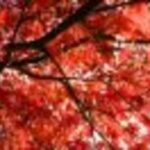The cool days of autumn lull trees into dormant sleep, and in their slumber they dream in glorious color. Their lazy branches float back and forth like waves on the beach, and there, in the wash of the wind, their foliage transforms into beautiful reds, yellows, oranges, and purples. Their many colors and shapes merge, resembling stained glass windows against fall’s azure sky. You don’t have to see this display from a distance. It can be yours, literally!
First all you have to start with is a quick stroll around your yard and see what you already have. Such native trees as dogwoods, black gums, sourwoods, hickories, and sweet gums simply glow in the fall. If you’re lucky enough to have some of these just accent them with additional trees.
Ornamentals – Japanese maples, ginkgoes, and Chinese pistache, to name a few, also shine during this season. Japanese maples are especially geared for small yards. Use the species as a specimen, or plant it in small groups of three for a show of red, yellow, or orange. Try the selection ‘Glowing embers.’ There is also ‘Emperor I’ and ‘Bloodgood,’ they are beautiful, use these two as specimens. For tight spots in your garden, and for large containers, try even smaller selections of Japanese maples such as “Tamukeyama,” Red Dragon,’ and ‘Inaba Shidare.”
In large yards, consider using a ginkgo for a golden show of color in a special spot in your landscape. This tree generally grows slowly but becomes more beautiful with age. Your patience will pay off. Plant named selections such as ‘Autumn Gold,’ ‘Princeton Sentry,’ ‘Shangri-La,’ and ‘Saratoga.’
Chinese pistache needs some room to fill out and is one of the most underused trees in the South. Its luminous fall foliage can vary, from yellows to oranges and reds. You can plant one in a special place or use several to frame your yard.
Regardless of which trees you choose, now is the time to plant. You can accent their fall foliage by placing them near evergreens such as magnolias, pines, cedars, and hollies. Be sure to water them well once they’re planted. Then add a 2 to 3-inch layer of mulch (pine straw, chopped leaves, or pine bark) to keep roots cool, retain moisture, and slow weed growth. Keep your trees mulched year-round, but be careful to to pile mulch against eh trunk, which invites insects and other problems.
With our new trees in place, just relax and let the cool air help them settle in, spread their roots, and gather strength for next year’s growing season. Before you know it, you’ll be looking up at the brilliant blue sky through a stained glass window of your own.
Ginkgo
Ginkgo biloba
This is one of the best Fan shaped, emerald green leaves turn fold as the days cool. Leaves then drop all at once creating a golden carpet. These trees generally grow slowly and work best as a specimen tree. Female trees produce foul-smelling fruit, so plant named male selections.
Scarlet Oak
Quercus coccinea
One of the finest trees in the South for fall color; however, color can be inconsistent. Glossy, dark green leaves turn a bright red during the latter part of autumn. It grows well in moist, acid soil. This is a large-growing shade tree, so it needs lots of room.
Chinese Pistache
Pistacia chinensis
This tree’s fall color can be simply stunning, mimicking the glowing embers in a fireplace. Chinese pistache deserves to be more widely used. It needs some room and is best used as a medium-size shade tree. Lacy leaves can become yellow, orange, or red.
Sweet gum
Liquidambar styraciflua
Though some curse its prolific fruit, beautiful autumn color is this tree’s saving grace. Starlike leaves can come in yellows, oranges, reds, and purples. Fruitless or near fruitless selections include ‘Cherokee’ and ‘Rotundiloba.’
Red Maple
Acer rubrium
This adaptable tree grows fast and works well as a large shade tree. It is tolerant of different soils, making it easy to use. Fall color can be early and ranges from oranges to reds. Choose names selections such as ‘autumn flame,’ ‘October Glory,’ and ‘Red sunset.’
Dogwood
Cornus Florida
One of the favorite trees of spring in the south, dogwood also shines in the fall. Trees can be multihued, in yellows, oranges, reds, and purples, or single hued in reds or purples. Choose disease-resistant selections such as ‘Appalachian spring’ or ‘Cherokee Sunset.’
Japanese Maple
Acer palmatum
These graceful trees are small and dependable. Once established, they can become quite drought tolerant. Many selections are available. ‘Bloodgood,’ ‘Emperor I,’ ‘Glowing Embers,’ ‘Garnet,’ ‘Inaba Shidare,’ ‘Red Dragon,’ ‘Tamukeyama,’ and ‘Waterfall.’
Sugar Maple
Acer saccharum
This is the iconic tree of fall. Leaves turn bright yellows, oranges, and reds. Look for heat-tolerant selections such as ‘commemoration,’ and ‘Legacy.’ Southern sugar maple offers a great alternative for the warmer areas of the South.





